Introduction
Few things satisfy a craving quite like a basket of golden, crunchy chicken tenders and fries. This classic American comfort food has become a staple in homes, restaurants, and fast-food chains around the world. The tender, juicy chicken inside its crispy coating, paired with perfectly fried or baked potato fries, creates a harmony of flavors and textures that people of all ages adore. Whether you’re preparing a family-friendly dinner, hosting a weekend game day, or just treating yourself, chicken tenders and fries never fail to deliver.
In this ultimate guide, you’ll learn everything you need to know to make mouth-watering chicken tenders and fries right in your own kitchen. From the best ingredients to cooking techniques and even healthier alternatives, this in-depth article will help you master the art of this crowd-pleasing dish.
What Are Chicken Tenders and Fries?
Understanding Chicken Tenders
Chicken tenders, sometimes called chicken fingers or chicken strips, are thin slices of chicken breast that are breaded and fried or baked until crispy on the outside and juicy on the inside. Traditionally, they come from the tenderloin — a small strip of meat loosely attached to the underside of the chicken breast — but many home cooks and restaurants use sliced breast meat as a substitute..Chick-fil-A Grilled Nuggets Recipe
Chicken tenders stand out because of their consistent size and tenderness, making them perfect for breading and quick cooking. Their popularity has soared thanks to their kid-friendly appeal and easy-to-dip design.
Understanding French Fries
French fries, or simply “fries,” are thinly cut pieces of potato that are deep-fried or baked until they develop a crispy exterior with a fluffy interior. Originating in Europe, fries have become a global sensation and are a must-have side for countless fast-food and casual meals. When paired with chicken tenders, fries offer a perfect textural counterpoint: crunchy and salty with a soft bite that complements the juicy chicken perfectly.
Why the Combination Works
Why are chicken tenders and fries such a classic duo? It comes down to taste, texture, and familiarity. The crunchy exterior of the chicken plays perfectly against the crisp potato fries, while the interior of each offers a comforting, satisfying mouthfeel. Together, they deliver a nostalgic, universally loved flavor combination that is both simple and deeply satisfying..Chick-fil-A
With all this in mind, let’s dive deeper into the history of this beloved meal.
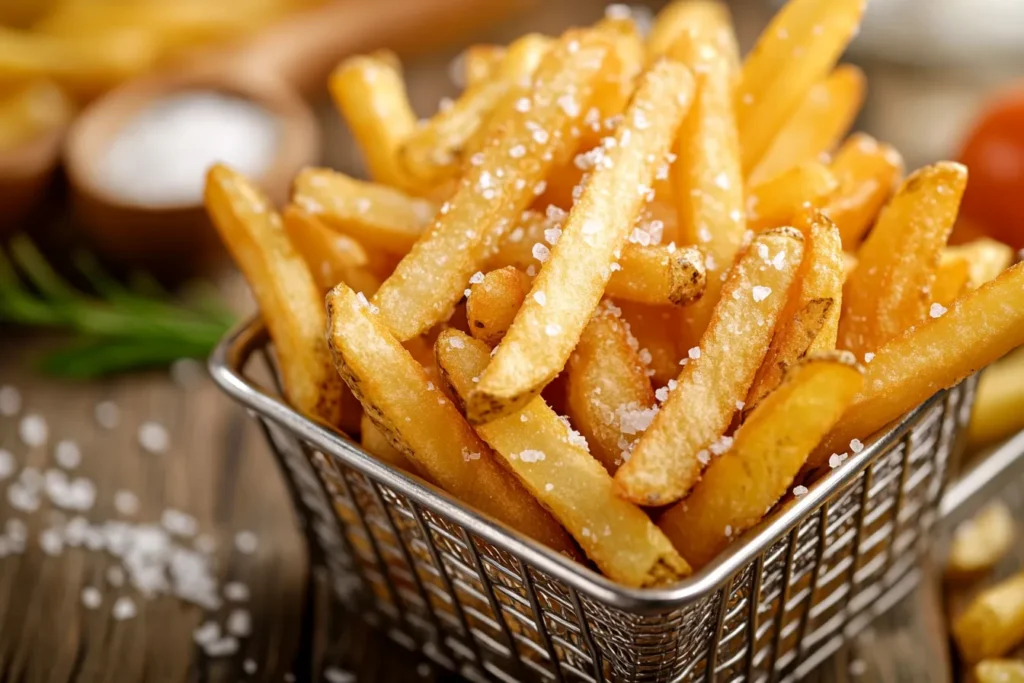
The History of Chicken Tenders
Origins of Fried Chicken
Fried chicken has been around for centuries, tracing its roots back to Scotland, where frying chicken in fat was a tradition, and to West African culinary practices brought to America by enslaved people. Combining spices and frying techniques, fried chicken evolved into a symbol of Southern cuisine in the United States. Over time, the love for crunchy, juicy chicken spread across the country and ultimately the world, giving birth to countless variations — including chicken tenders.
Fried chicken’s popularity rose dramatically in the 20th century with the rise of fast-food restaurants. Its irresistible crunch and portability made it a commercial success. That same cultural love for fried chicken naturally paved the way for more convenient, boneless options, like chicken tenders, that were easier to eat on the go or serve to children.
Rise of Chicken Tenders in Fast Food
While fried chicken was already a beloved dish, chicken tenders specifically gained momentum in the 1980s and 1990s. Fast-food chains recognized that boneless, smaller chicken pieces appealed to busy families and kids who wanted a convenient and tasty meal without bones to deal with. The consistent size, fast cooking time, and mild flavor of tenders made them an ideal product for quick-service restaurants.
Soon, chicken tenders were popping up on menus everywhere — from drive-through chains to family diners — often paired with golden fries to create a well-rounded, easy-to-love meal. This powerful duo quickly became one of America’s favorite comfort foods and remains so to this day.
Choosing the Best Chicken for Tenders
Boneless vs. Bone-In
When making chicken tenders at home, it’s essential to understand the difference between boneless and bone-in chicken. While bone-in chicken is fantastic for traditional fried chicken, tenders are best made with boneless cuts. The chicken tenderloin, located just beneath the chicken breast, is naturally tender and ideal for breading and frying. If you can’t find tenderloins, thin slices of boneless, skinless chicken breast will work perfectly well.
Boneless chicken makes the cooking process easier and faster. You can slice it evenly, ensuring every piece cooks at the same rate and delivers a juicy bite. Bone-in chicken, on the other hand, takes longer to cook and may be less consistent for this style of breaded tender.
Organic vs. Conventional
When shopping for chicken, you might wonder whether to buy organic or conventional. Organic chicken is raised without antibiotics and fed an organic diet, while conventional chicken is more affordable and widely available. From a taste and safety perspective, both work well for tenders, provided they are fresh and handled properly.
However, organic or pasture-raised chicken can have a slightly richer flavor and is often perceived as more humane and environmentally friendly. Regardless of your choice, always follow safe chicken cooking temperatures recommended by the USDA to ensure food safety.
Freshness Matters
Beyond labels, freshness is the biggest factor. Look for chicken with a healthy pink color, no foul odors, and minimal packaging liquid. The fresher the chicken, the juicier and more flavorful your tenders will be.
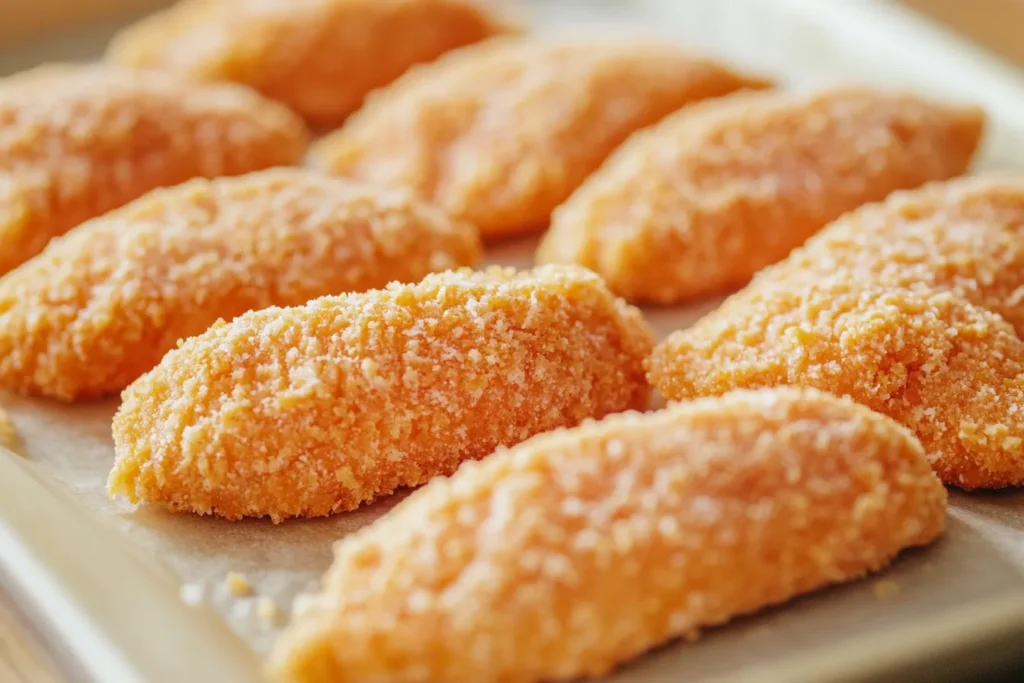
The Perfect French Fries
Best Potato Varieties
Choosing the right potato is critical to making fries that are crispy on the outside and fluffy on the inside. Russet potatoes, also known as Idaho potatoes, are widely considered the best for fries because of their high starch content and low moisture. This allows them to crisp up beautifully during frying or baking. Yukon Gold potatoes are another excellent option if you prefer a slightly creamier texture with a golden color.
It’s important to avoid waxy potatoes like red potatoes or fingerlings for classic fries. These types tend to hold too much moisture and can turn soggy rather than crispy.
Hand-Cut vs. Frozen Fries
Fresh, hand-cut fries offer a level of flavor and texture that store-bought frozen fries usually can’t match. When you cut your own fries, you control the size, shape, and freshness. Soaking freshly cut fries in cold water for at least 30 minutes before cooking removes excess starch and helps them stay crisp.
That said, frozen fries have come a long way. Many brands partially cook and flash-freeze their potatoes for a product that is surprisingly tasty and convenient. For busy cooks, frozen fries are a solid alternative — just make sure to follow package directions carefully and avoid overcrowding the pan so they stay crunchy.
Seasoning Your Fries
French fries aren’t complete without the right seasoning. A simple sprinkle of kosher salt works beautifully, but you can also experiment with flavors like garlic powder, smoked paprika, Cajun seasoning, or even a bit of grated Parmesan cheese. Season fries immediately after cooking so the salt sticks while they’re hot.
The Secret to Crispy Coating
Flour, Panko, or Cornstarch?
When it comes to breading chicken tenders, the coating is what makes or breaks the dish. Classic breading usually includes all-purpose flour, which helps the egg wash stick to the chicken. Panko breadcrumbs, a Japanese-style crumb, create an especially crunchy crust. Some cooks even add cornstarch to their flour mixture for a lighter, crispier finish.
The key is to dredge the chicken evenly. A three-step breading process — flour, egg wash, then breadcrumbs — is a proven method to get that satisfying crunch. For extra flavor, season each layer lightly with salt, pepper, garlic powder, or paprika.
Seasoning Techniques
Seasoning goes beyond salt and pepper. Mixing herbs and spices right into your flour or breadcrumb blend helps layer the flavor directly into the crust. You can use cayenne for heat, oregano for a Mediterranean kick, or even a touch of curry powder for a unique twist.
Also, let the breaded chicken rest for a few minutes before frying. This helps the coating stick better and prevents it from falling off during cooking.
Pro Tips for Crunch
To keep your chicken tenders perfectly crispy, fry them in small batches. Crowding the pan lowers the oil temperature and leads to soggy breading. Also, maintain your oil temperature around 350–365°F (175–185°C) for best results — use a thermometer to monitor it, just like the Serious Eats Chicken Frying Guide recommends.
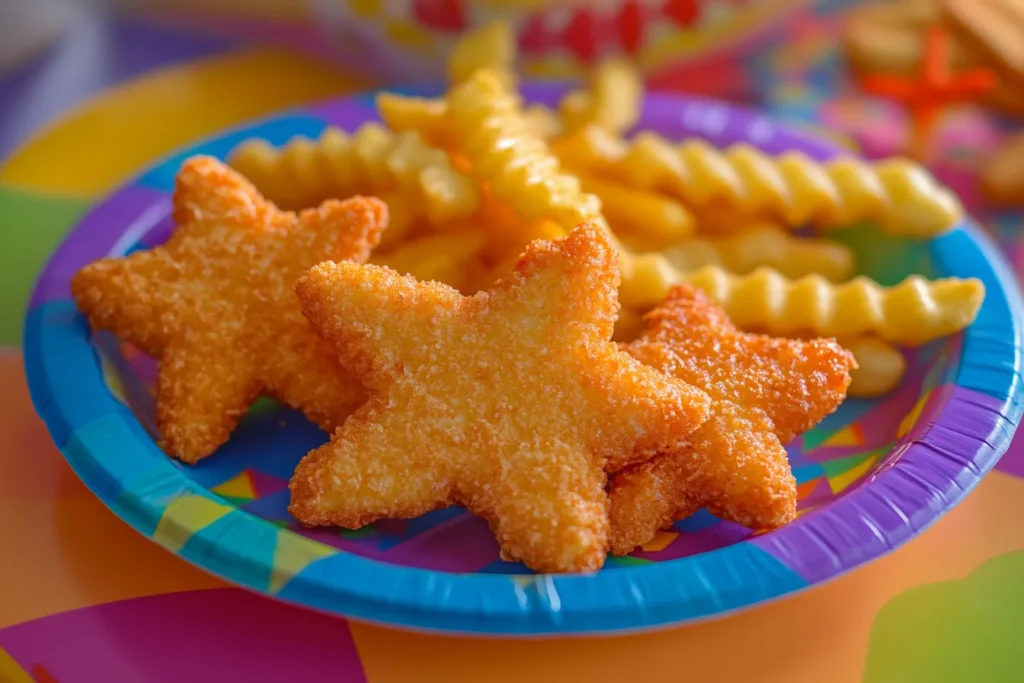
How to Fry Like a Pro
Oil Temperature Tips
Perfectly fried chicken tenders come down to oil temperature control. If your oil is too cold, the breading will soak up the oil and turn greasy. If it’s too hot, the outside burns before the inside cooks through. Aim for 350–365°F (175–185°C) to get that golden brown finish while ensuring the chicken cooks evenly.
Use a kitchen thermometer to keep an eye on your oil. Let it recover to temperature between batches. Skimming out stray crumbs between rounds also prevents burning and off-flavors. For a consistent result, use a deep, heavy pot with plenty of room for the chicken to move around.
Shallow Fry vs. Deep Fry
You can shallow-fry tenders in a skillet with about an inch of oil, or deep-fry them fully submerged. Deep-frying generally yields a more even crust, while shallow-frying can work well if you flip the tenders frequently and monitor the heat. Both methods are delicious if you manage the temperature carefully.
If you’re worried about using too much oil, shallow-frying is an economical choice, but deep-frying can often feel easier and more consistent since the tenders float freely.
Baked vs Fried Chicken Tenders
Taste Comparison
Fried chicken tenders undeniably bring that crave-worthy crunch, but baked tenders have their own merits. When breaded properly and baked at a high temperature, oven-baked tenders can come close to the deep-fried crunch with far less oil. Many people find them lighter and easier to digest.
If you want to replicate the crispiness of fried tenders in the oven, place them on a wire rack set over a baking sheet, spray lightly with cooking oil, and bake at 425°F (220°C) until golden. This method lets air circulate around the tenders for a crunchy exterior without deep-frying.
Health Benefits
While fried chicken tenders are a treat, baking reduces calories and saturated fat significantly. If you’re cooking for kids or trying to stick to a healthier diet, baked tenders can be a smart swap. Still, occasional fried tenders are absolutely fine as part of a balanced meal, especially if paired with a side of vegetables or a salad, following guidance like the Healthy Cooking Plate from Harvard.
Pairing Sauces for Dipping
Classic Ranch
Creamy ranch dressing is a go-to dip for chicken tenders thanks to its mild, tangy flavor. The herbs in ranch balance out the saltiness of the breading and provide a refreshing contrast to the fried crust.
Spicy Buffalo
For spice lovers, Buffalo sauce offers a tangy, fiery punch. Its vinegar base cuts through the richness of fried tenders, delivering a mouthwatering heat that pairs especially well with crispy fries.
Honey Mustard
Honey mustard is a sweet-and-savory dipping sauce perfect for kids and adults alike. The honey complements the mild chicken, while the mustard gives just enough bite to keep things interesting.
Of course, you can get creative — barbecue sauce, chipotle mayo, and even Asian-style sweet chili sauce are all excellent pairing options to explore.
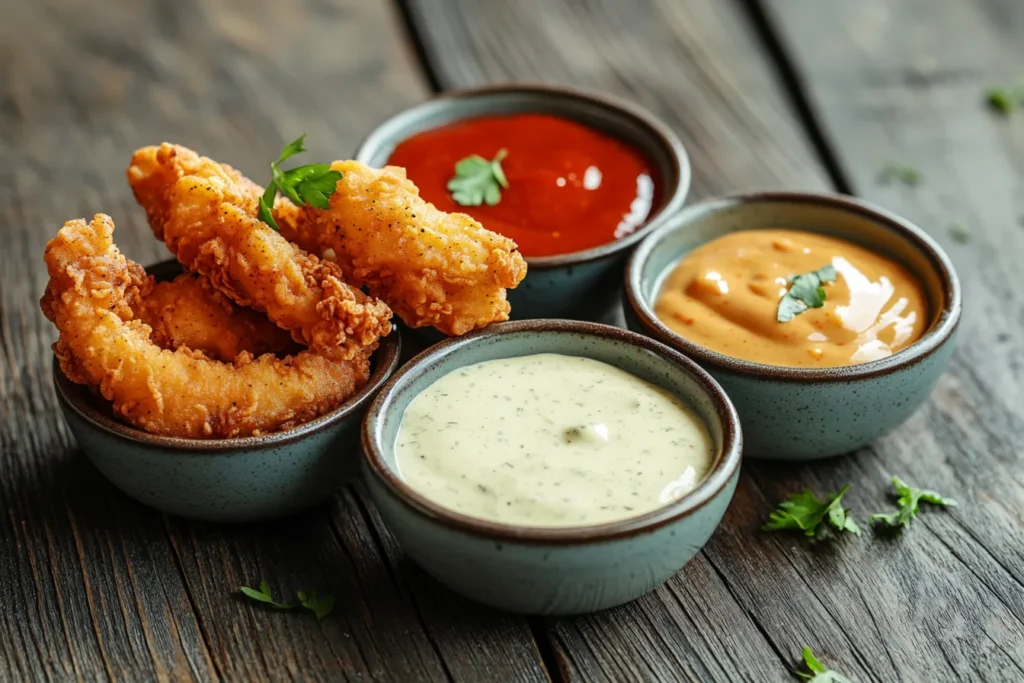
Kid-Friendly Chicken Tenders and Fries
Fun Shapes
One of the reasons chicken tenders and fries are so popular with kids is their playful appeal. You can easily make them even more fun by cutting tenders into shapes like stars or hearts using cookie cutters, especially if working with chicken breast fillets. The same can apply to fries — consider making crinkle-cut or wedge fries to add variety and fun to your plate.
Kids love dipping and sampling different shapes, so these creative twists can encourage even picky eaters to join the mealtime excitement.
Portion Sizes
Children don’t need adult-sized portions. For younger kids, 2–3 tenders with a small handful of fries is plenty. For older kids and teenagers, you can scale up the portion while keeping the overall meal balanced. Adding a side of carrot sticks, celery, or a simple green salad can help provide more nutrition and color to the plate.
Encouraging kids to help with breading the chicken or arranging the fries on the baking tray is another great way to get them involved and excited about eating homemade food.
Nutrition Facts
Calories and Protein
Chicken tenders are a solid source of protein, providing about 15–20 grams per 3-ounce serving depending on preparation. However, fried chicken tenders can be high in calories due to the oil absorbed during cooking. On average, a serving of three fried tenders can reach around 300–400 calories, while baked tenders might be closer to 200–250 calories.
Fries, too, pack a calorie punch. A medium portion of fries contains roughly 300 calories. Pairing tenders and fries together makes for a delicious but calorie-dense meal, which is why it’s best enjoyed in moderation or balanced with fresh vegetables.
Tips to Make Them Healthier
Here are a few ways to lighten up your chicken tenders and fries:
- Bake instead of deep-fry.
- Use whole-wheat breadcrumbs or panko.
- Spray lightly with olive oil rather than fully immersing in oil.
- Choose sweet potato fries for extra fiber and nutrients.
- Pair with a fresh salad or veggie sticks.
By making small adjustments, you can turn this classic dish into a more nutritious and well-rounded meal while keeping all its delicious flavor.
Common Mistakes to Avoid
Undercooking
One of the biggest mistakes is undercooking chicken tenders. Always ensure the internal temperature reaches at least 165°F (74°C) as recommended by the USDA. A meat thermometer is your best friend here, helping you prevent foodborne illnesses.
Overcrowding the Pan
Another common error is trying to fry too many tenders at once. Overcrowding the pan lowers the oil temperature and leads to soggy breading. Cook in small batches, giving each tender enough space to crisp up beautifully.
Ignoring Rest Time
After frying, let your tenders rest on a wire rack rather than on paper towels. A rack allows air to circulate, preventing soggy bottoms and preserving their crunchy texture.
These small yet crucial steps will keep your chicken tenders and fries crispy, flavorful, and safe to eat every single time.
FAQs
How do you store leftover chicken tenders and fries?
Leftovers should be cooled completely and stored in an airtight container in the refrigerator for up to 3 days. For best results, keep the tenders and fries separate so they don’t get soggy from each other’s moisture.
Can you air-fry chicken tenders and fries?
Absolutely! Air fryers are a fantastic way to achieve a crispy texture with far less oil. Simply bread your chicken tenders as usual, spritz with a light coat of oil, and air-fry at 400°F (200°C) for 8–10 minutes, flipping once halfway through. For fries, do the same — toss in a little oil and season, then air-fry until golden.
How can you reheat chicken tenders to keep them crispy?
The oven or air fryer works best for reheating. Avoid the microwave, which makes breading soggy. Preheat your oven to 375°F (190°C) and warm the tenders on a wire rack for 8–10 minutes.
What is the best dipping sauce for kids?
Kids usually love ranch or honey mustard. Both are mild, creamy, and pair perfectly with the savory chicken tenders. Ketchup is also a classic winner with fries.
Can you freeze homemade chicken tenders?
Yes! After breading the tenders, place them on a baking sheet and freeze individually. Once solid, transfer to a freezer bag for up to 2 months. Bake directly from frozen at 400°F (200°C) until cooked through.
Are sweet potato fries a good substitute?
Sweet potato fries are an excellent, nutritious alternative with more fiber, vitamins, and a touch of natural sweetness that complements chicken tenders beautifully.
Conclusion
There’s a reason chicken tenders and fries have stayed a beloved comfort food for generations. With their crispy coating, juicy chicken, and perfectly golden fries, they offer a nostalgic and satisfying meal that appeals to everyone from toddlers to grandparents. By understanding how to choose quality ingredients, master breading techniques, and manage oil temperatures, you can recreate restaurant-worthy tenders and fries right at home.
Whether you fry, bake, or air-fry them, these tips will help you serve up a platter that’s fresh, crunchy, and absolutely delicious. Don’t be afraid to experiment with seasonings, dipping sauces, and side dishes to make the meal your own. After all, nothing beats a homemade version of this timeless classic.
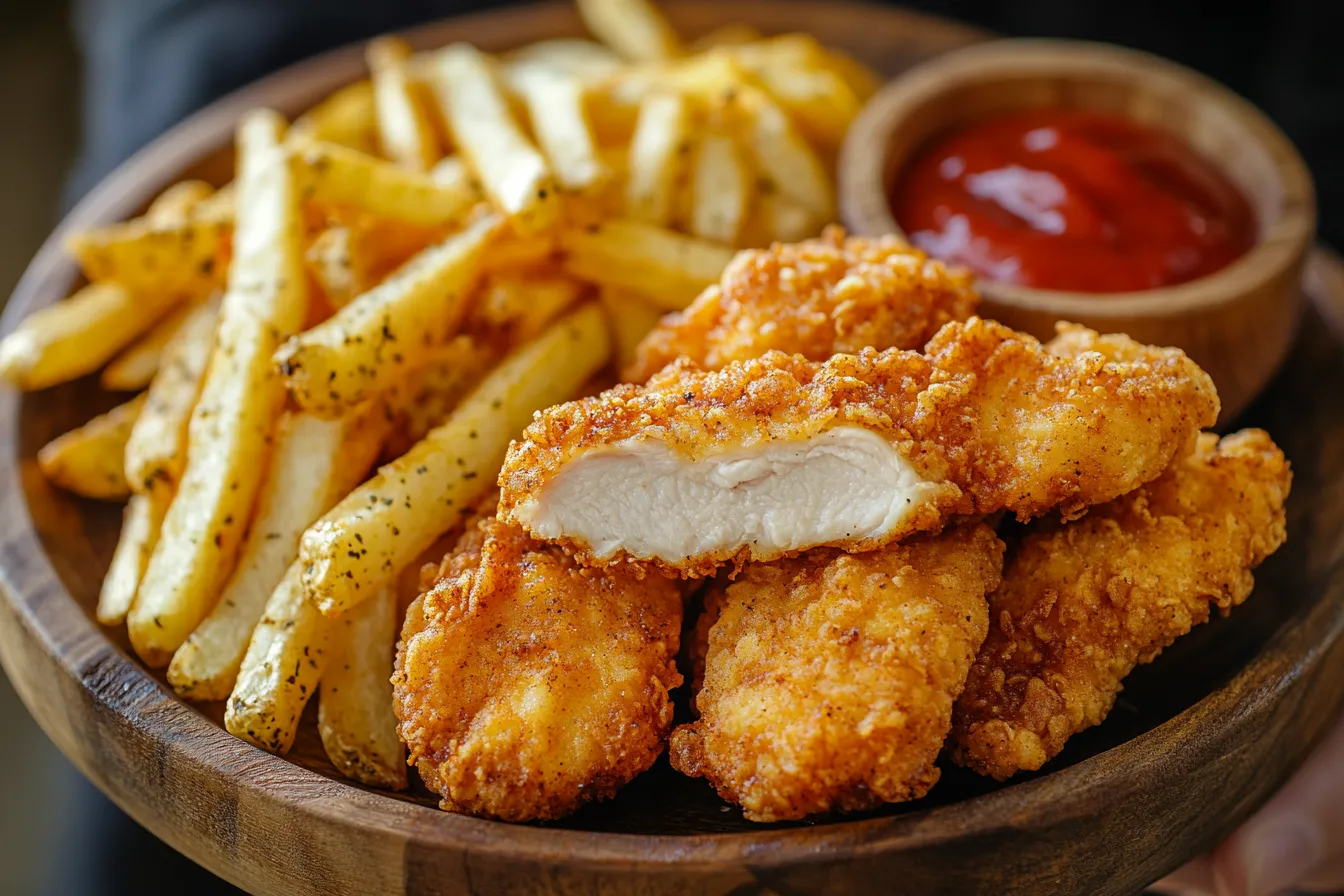
Name: Chicken Tenders and Fries
Ingredients
Equipment
Method
- Instructions:
- 1️⃣ Prepare the fries:
- Soak potato slices in cold water for at least 30 minutes, then drain and pat dry.
- Toss with 2 tablespoons of vegetable oil, salt, and pepper.
- Bake at 425°F (220°C) on a baking sheet for 25–30 minutes, flipping halfway through, until golden and crispy.
- 2️⃣ Bread the chicken:
- Mix flour with half the spices in a shallow bowl.
- Place beaten eggs in a second bowl.
- Mix panko with the remaining spices in a third bowl.
- Dredge chicken tenders in flour, dip in egg, then coat with panko mixture.
- Rest breaded tenders on a wire rack for 5–10 minutes.
- 3️⃣ Fry the chicken:
- Heat oil to 350–365°F (175–185°C).
- Fry chicken tenders in batches for 4–5 minutes per side, or until golden brown and internal temperature reaches 165°F (74°C).
- Drain on paper towels or a wire rack.
- 4️⃣ Serve:
- Plate hot tenders with fries, along with your favorite dipping sauces.
